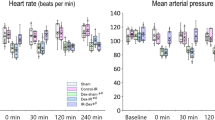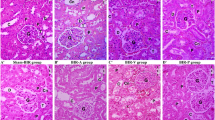Summary
Post-ischemic renal failure is associated with a zone of vascular hyperaemia in the outer medulla of the kidney. The effect of this lesion on regional renal perfusion is, however, unclear. Acute unilateral renal ischemia was applied to four groups of ten adult male Wistar rats for a period of 60 min, followed by revascularisation for 0, 15, 30 or 60 min. The aorta was then clamped and Microfil was injected at a standard pressure to fill the renal vasculature. Gross and histological examinations of the renal parenchyma and vasculature were then performed. Regional renal Microfil perfusion was quantified by examination of unstained histological sections, giving rise to a vascular perfusion index (VPI) for each vascular region of the kidney. The VPIs were similar in control and ischemic kidneys that were not subjected to reflow (group 1). In contrast, the VPI was markedly decreased in the inner stripe and inner medulla in animals in which revascularisation had occurred (groups 2–4), and the vasculature in these regions was histologically shown to be packed with red blood cells. Post-ischemic renal failure is associated with hyperperfusion of the medulla resulting from blockage of the vasculature that occurs during revascularisation.
Similar content being viewed by others
References
Bjork J, Del Maestro RF, Arfors KE (1980) Evidence for participation of hydroxyl radical in increased microvascular permeability. Agents Action [Suppl] 7:208
Fitzpatrick JM, Monson JRT, Gunter PA, Watkinson LE, Wickham JEA (1982) Renal accumulation of ammonia: the cause of post-ischeamic functional loss and the “blue line”. Br J Urol 54:608
Flores J, diBona DR, Beck CH, Leaf A (1972) The role of cell swelling in ischemic renal damage and the protective effect of hypertonic solute. J Clin Invest 51:118
Frega NS, DiBona DR, Guertler B, Leaf A (1976) Ischemic renal renal injury. Kidney Int 10 [Suppl 6]:17
Hansson R, Gustafsson B, Jonsson O, Lundstam S, S Pettersson, Schersten T, Waldenstrom J (1982) Effect of xanthine oxidase inhibition on renal circulation after ischemia. Transplant Proc 14:51
Karlberg L, Norlen BJ, Ojteg G, Wolgast M (1983) Impaired medullary circulation in post-ischemic acute renal failure. Acta Physiol Scand 118:11
Mason J, Welsch J (1982) Glomerular filtration of the deeper lying nephrons after ischemic injury. Nephron 31:304
Mason J, Torhorst J, Welsch J (1984) Role of the medullary perfusion defect in the pathogenesis of ischemic renal failure. Kidney Int 26:283
Rougemont D de, Brunner FP, Torhorst J, Wunderlich PF, Thiel G (1982) Superficial nephron obstruction and medullary congestion after ischemic injury: effect of protective treatments. Nephron 31:310
Schurek HJ, Kriz W (1985) Morphologic and functional evidence for oxygen deficiency in the isolated perfused rat kidney. Lab Invest 53:145
Summers WK, Jamison RL (1971) The no reflow phenomenon in renal ischemia. Lab Invest 25:635
Thiel G, Rougemon D de, Torhorst J (1980) Importance of tubular obstruction and its prevention in ischemic acute renal failure in the rat. In: Leaf, Giebisch, Bolis, Gorini (eds) Recent advances in renal pathophysiology. Raven Press, New York, p 223
Thiel G, Rougemont D de, Kriz W, Mason J, Torhorst J, Wolgast M (1982) The role of reduced medullary perfusion in the genesis of acute ischemic renal failure. Nephron 31:321
Torhorst J, Rougemont D de, Brunner FP, Thiel G (1982) Morphology of the renal medulla in ischemic acute renal failure in the rat. Nephron 31:296
Wickham JEA, Sharma GP (1965) Endogenous ammonia formation in experimental renal ischemia. Lancet I:195
Wolgast M, Karlberg L, Kallskog O, Norlen BJ, Nygren N, Ojteg O (1982) Haemodynamic alterations in ischemic acute renal failure. Nephron 31:301
Author information
Authors and Affiliations
Rights and permissions
About this article
Cite this article
Lennon, G.M., Ryan, P.C., Gaffney, E.F. et al. Changes in regional renal perfusion following ischemia/reperfusion injury to the rat kidney. Urol. Res. 19, 259–264 (1991). https://doi.org/10.1007/BF00305308
Accepted:
Issue Date:
DOI: https://doi.org/10.1007/BF00305308




